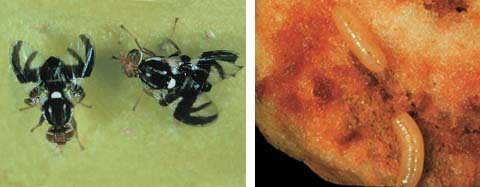
Left: The apple maggot is about the size of a house fly and has distinctive markings on its wings, a white patch on its thorax, and red eyes. Right: Apple maggot larvae hatch from eggs laid under the fruit skin and develop there for up to seven weeks before.
Last summer, Dan McCarthy got the phone call he’d been dreading. Washington State Department of Agriculture trappers had found the first apple maggot in Okanogan County, Washington. The apple maggot was first found in the Pacific Northwest in 1979. Trapping showed that it was already established in parts of western Washington, Oregon, and California. Since then, it has been found throughout Western Washington, along the Columbia Gorge, and around Spokane in eastern Washington.
In recent years, it has turned up in the apple producing regions of the Tri-Cities, Ellensburg, and Yakima in eastern Washington, though it has only been found in wild and backyard trees and never in a commercial orchard.
The insect is considered a serious threat to commercial orchards because it would force growers to spray to control it, and certain export markets don’t accept fruit from areas with the maggot.
Hawthorn is its native host, but the insect also infests apple, crab apple, pear, plum, cherry, cotoneaster, and pyracantha. It prefers early maturing varieties of apples, such as Gala.
The state Department of Agriculture has quarantined parts of Washington State in an effort to slow the spread of the pest and through detection and control. Quarantined areas include western Washington, Skamania, Klickitat, and Spokane Counties, and parts of Kittitas and Yakima Counties. Residents are asked not to transport homegrown fruit out of quarantined areas, and commercial orchardists cannot ship fruit out unless the orchard has been certified to be free of apple maggot through trapping or field sampling.
Freight train
But the maggot continues its advance. In 2005, a single maggot was found in a hawthorn tree near the cemetery in Wenatchee. In 2006, the WSDA conducted high density trapping in the area and found no more flies in that area, but it did find one fly in Manson, one in Peshastin, and one in Ephrata, as well as the one in Okanogan County that triggered the call to McCarthy. McCarthy, who is fieldman for the Okanogan County Pest and Disease Board, said the apple tree where the maggot was trapped is one of three in the front yard of a home near Twisp in the upper Methow Valley. The trees were also heavily infested with codling moth. The upper valley has lost most of its commercial apple acreage over the past 40 years, but many wild apple trees and native hosts remain, and many of the property owners are not resident there.
“I felt from the beginning that would be where we would first discover apple maggot,” said McCarthy, who has been on the Apple Maggot Working Group for the past decade. “Apple maggot is sort of like a freight train. You can see it coming, and you just try to do what you can to stay out of the way, but it’s coming down the tracks.”
The Department of Agriculture will conduct intensive trapping in areas where the maggot was trapped last season to find out if the pest has become established and will remove wild host trees.
McCarthy said he removed the fruit from the Twisp tree last season and sprayed the tree. He’ll treat it again this year to target any overwintering apple maggots that might emerge and will eventually cut the tree down.
“We’re hoping this is just an isolated catch, and we’ll be able to maintain our pest-free status for years to come,” he said.
But the changing demographic composition of Okanogan County, with home sites rapidly taking the place of orchards, makes protecting the area from the pest a challenge, McCarthy said. “We have our work cut out to keep these backyard trees either sprayed or cut down.”
Related to cherry fruit fly
The apple maggot, Rhagoletis pomonella, is related to the cherry fruit fly and walnut husk fly. They can be distinguished from each other by their different wing markings. The apple maggot fly has red eyes and a distinctive white patch on the thorax. Another insect, the snowberry maggot, is almost identical to the apple maggot, however.
Female apple maggot adults, which are about the size of houseflies, lay eggs underneath the skin of the fruit where they are protected from pesticides. The larvae hatch in three to seven days. Larvae are about one-quarter inch long and have distinctive mouth hooks that they use to pull themselves through the flesh of the fruit, McCarthy said.
A larva can take two to seven weeks to develop inside the fruit, depending on the weather. When the fruit falls to the ground, the larva exits and burrows two to three inches into the ground where it pupates. It remains in the ground as a pupa, which looks similar to a grain of wheat. The following summer, it emerges from diapause as an adult fly.
Flies rest and feed for about seven days before becoming sexually mature. The flies feed on secretions from the tree and bird manure. This is an important time to control the pest, before the females lay their eggs under the skin of the fruit, McCarthy said. Most of the insecticides used to control cherry fruit fly will also control the apple maggot, but they can be disruptive of an integrated pest management program.

Leave A Comment